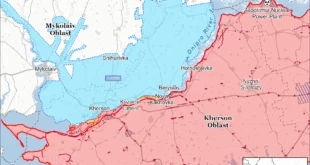In today’s summary:
- The combat zone in the Kursk region has stabilized – the RF Armed Forces recaptured the village of Korenevo, the Armed Forces of Ukraine isolate the Glushkovsky district
- The Ministry of Defense of the Russian Federation and Z-figures compare the “heroic defense” of the women’s colony in the Kursk region with the Brest Fortress
- The command of the RF Armed Forces is pulling exotic units to the Kursk direction – including from Burkina Faso
- The Armed Forces of Ukraine failed to divert Russian forces from the Pokrovsky direction – fighting is going on in Selidovo and on the outskirts of Pokrovsk
- The largest air raid on Ukraine during the war – 127 missiles were fired (102 shot down) and 109 drones were fired (99 shot down)
- The first Ukrainian F-16 fighter was lost, followed by the resignation of the commander of the Air Force of the Armed Forces of Ukraine
- The first exchange of prisoners after the start of the operation in the Kursk region: conscripts returned to Russia, defenders of Mariupol returned to Ukraine
- Volodymyr Zelenskyy announced the successful test of a Ukrainian-designed ballistic missile
- The situation at the front
- After more than 20 days of fighting in the Kursk region, the front line in the region has practically frozen. The Russian military managed to knock out the Armed Forces of Ukraine from the village of Korenevo, located near the district center of the same name, and in general remove the threat of encirclement of the latter. Ukrainian forces, in turn, expanded the zone of presence in the east of the Glushkovsky district, occupying Byakhovo, Viktorovka and Uspenovka, and continued to take measures to isolate the area from the “mainland”, striking at pontoon crossings and the remains of bridges over the Seym River (1, 2). One of these strikes reportedly killed a family trying to leave the area by car on a damaged bridge. In the settlements of the Glushkovsky district, where there are no Ukrainian soldiers, cases of looting by people in camouflage uniforms continued to be noted (1, 2, 3).
The Ministry of Defense of the Russian Federation and Z-figures, meanwhile, tell the story of the “heroic defense” of the women’s penal colony No 11 in Malaya Lokna, comparing it with the Brest Fortress. According to them, the Russian military held out with small arms against heavy equipment – although, unlike the real Brest Fortress, they eventually withdrew from the territory of the colony.
The Insider published a report from the part of the Kursk region occupied by Ukrainian troops. Correspondent Tatyana Popova managed to talk to civilians who remained in their homes, mostly lonely pensioners. Some of them spent more than a week in shelters, there is no water and electricity in their homes, and some public buildings have been destroyed.
Meanwhile, the Russian command continues to transfer motley and exotic reinforcements to the Kursk region. We are talking about individual units from different sectors of the front, newly formed units, mercenaries who served in Burkina Faso, and conscripts, including those who recently took the oath. Some conscripts are recruited from the Strategic Missile Forces. The Russian side is also building fortifications, including just 10 kilometers south of Kurchatov, where the Kursk nuclear power plant is located. Entry into the city itself is restricted, checkpoints are set up on the roads.
The Ukrainian military operating in the region complains about the increased resistance of the RF Armed Forces and the “shell hunger”. Roman Alekhin, a Z-activist and adviser to the acting governor of the Kursk region, in turn, criticizes the supply problems of the Russian group, in particular the lack of communications equipment and drones, and calls on local residents to evacuate, since during the Russian counteroffensive (signs of which there are no signs yet), their settlements will be “wiped off the face of the earth.” Finally, volunteers and “military volunteers” who arrived in the region are dissatisfied with the speeding fines they receive when trying to get away from FPV drones, as cameras on the roads of the region continue to work.
A new article by The Insider talks about the reasons for the success of the Armed Forces of Ukraine in the Kursk region. The Ukrainian command managed to impose a maneuver war on the enemy, in which the Ukrainian army shows itself much better than the Russian one due to the superiority in the quality of communications and the training of commanders and soldiers. However, the stabilization of the front risks turning the battles on the territory of Russia into positional warfare, where the RF Armed Forces already enjoy the advantage due to multiple superiority in artillery and manpower.
The situation in the Pokrovsky direction developed much more dramatically for the Ukrainian forces. Commander-in-Chief of the Armed Forces of Ukraine Alexander Syrsky admitted that one of the goals of the Kursk operation – to distract Russian troops from Donbass – has not yet been achieved. Russian troops captured individual settlements in this area almost every day, in particular, quite quickly almost completely occupied the city of Novogrodivka with a pre-war population of 14 thousand people. The RF Armed Forces reached Selidov and engaged in battles in urban areas. Also, the Ukrainian military left Karlovka, which was under the threat of encirclement.
At the same time, Volodymyr Zelenskyy is confident that after the start of the operation of the Armed Forces of Ukraine in the Kursk region, the Russian advance in the Pokrovsky direction slowed down, but OSINT analysts (1, 2) indicate that, on the contrary, it has accelerated. Zelensky may have been misinformed by false reports, which Ukrainian volunteers and military bloggers cite as one of the causes of the defense crisis, along with a shortage of personnel, a lack of interaction between units, and countering Ukrainian drones by their own electronic warfare means. Deputy of the Verkhovna Rada Mariana Bezuhlaya, known for criticizing the Ukrainian command, in turn, blames the situation on poorly conducted rotations and, as a result, the complete absence of people in the trenches. At the same time, it is emphasized that the Ukrainian military continues to put up fierce resistance, and the successes of the RF Armed Forces are still achieved mainly through “meat assaults”.
To the south, in the area of the Ugledar salient, Russian troops almost completely occupied Konstantinovka and launched an offensive on Vuhledar itself, trying to envelop it from the flanks. In addition, there was some progress in the Bakhmut direction, and in Sinkovka in the Kupyansk direction, the RF Armed Forces carried out a “flagovtyk” – however, DeepState claims that the village was not surrendered, and the group with the flag was simply “overlooked”. Ukrainian troops, in turn, tried to break through the border in the Belgorod region – but the attack was reportedly carried out by small forces and was unsuccessful.
The Z-public was extremely agitated (1, 2, 3, 4) by the news of the arrest in France of the CEO of the Telegram messenger Pavel Durov. The fact is that in the absence of secure military communications, Telegram is widely used in the Russian army for combat control, intelligence transmission and adjustment of artillery fire, which means it contains a huge amount of sensitive information, which, as the Z-authors fear, may now be at the disposal of Western intelligence services.
Mutual shelling and sabotage
At the beginning of the week, Ukraine was subjected to the largest air raid during the war. According to the Air Force Command of the Armed Forces of Ukraine, at least 127 missiles (102 shot down) and 109 UAVs (99 shot down) were fired. F-16 fighters were also used to repel the attack. 15 regions of Ukraine were affected, the strikes mainly fell on the energy infrastructure: “arrivals” were recorded at the Kyiv hydroelectric power plant, individual power units of Ukrainian nuclear power plants were turned off, emergency power outages were introduced throughout the country. In total, seven people were killed and another 47 were injured as a result of the attack.
In addition, during the week, the Ukrainian military reported repelling the following missile and drone raids:
on the night of August 25, the RF Armed Forces attacked the frontline regions of Ukraine with an Iskander-K cruise missile, an Iskander-M ballistic missile and six Kh-59/Kh-69 guided air missiles. Eight out of nine Shaheds were shot down over the Mykolaiv region;
on the night of August 27, 10 missiles were launched (five shot down) and 81 Shahed missiles (60 shot down). At least six Shaheds flew to Belarus. In the Zaporizhzhia region, as a result of a night attack, two civilians were killed, four were injured;
on the night of August 29, Ukrainian air defense systems intercepted 60 out of 74 Shaheds, as well as two of the three Kh-59/Kh-69 guided missiles. Two more unidentified missiles were also launched, the interception of which was not reported. One of the Shahed missiles once again flew into the airspace of Belarus, the Belarusian military used aviation against a Russian UAV for the first time;
on the night of August 30, the RF Armed Forces launched 18 Shaheds, of which 12 were shot down, and an Iskander-M ballistic missile was also launched.
In addition, during the week, Russian troops attacked two radar stations in the Sumy region (1, 2), hit a previously destroyed bridge in the same region and fired missiles at Zmiinyi Island in the Black Sea, where the Ukrainian garrison was allegedly located.
On the night of August 25, a hotel in Kramatorsk, Donetsk region, was attacked, four Reuters journalists were injured, and their security adviser was killed. On August 30, Kharkov was shelled with UMPB D-30 ammunition, one of the strikes fell on a high-rise building, six dead and 97 injured were reported. As a result of the retaliatory shelling of Belgorod from the MLRS, five people were killed, another 37 were injured.
Also, the dead and wounded as a result of shelling were reported in the Dnipropetrovsk (1, 2, 3), Donetsk (1, 2), Kharkiv and Sumy regions.
During the week, the Ministry of Defense of the Russian Federation reported on the repulsion of Ukrainian raids on Russian regions and the Crimean peninsula:
on the night of August 24, according to the department, seven UAVs were destroyed; an ammunition depot in the Voronezh region was hit, an emergency mode was introduced in neighboring settlements of the Ostrogozhsky district due to the detonation of “explosive objects”;
on the night of August 26, 20 UAVs were destroyed;
on the night of August 27 – 5 UAVs;
on the night of August 28 – 12 UAVs; the oil depot of the Atlas Rosrezerv plant in the Rostov region, which as of August 30 continued to burn, was hit; also, drones flew to the Kirov region for the first time, hitting an oil depot in the city of Kotelnich, which the Ministry of Defense did not report;
on the night of August 29 – 6 UAVs and 3 BECs;
on the night of August 30 – 18 UAVs.
Thus, according to the parties, during the week, Russian forces launched at least 291 drones and 151 missiles at Ukraine, Ukrainian forces responded with 71 drones (including naval ones).
Also during the week, Ukrainian troops struck a training ground in the occupied territory in the east of the country with HIMARS MLRS and an FPV drone on an electrical substation in Glushkov, Kursk region. In addition, according to satellite images from August 30, the fire at the oil depot in Proletarsk, Rostov region, continued for the 13th day, although it began to subside. In total, 20 tanks with a volume of up to 500 cubic meters of fuel each burned out or were damaged.
In addition, reports continued to be received about the dead and wounded as a result of shelling of the border area of the Belgorod region (1, 2, 3, 4, 5). In the region, the resettlement of four villages has begun, schools in the 20-kilometer border zone have been transferred to a distance learning model.
Loss
The General Staff of the Armed Forces of Ukraine reported the crash of the first Ukrainian F-16. Apparently, the incident occurred during the repulsion of a Russian raid on August 26, while Lieutenant Colonel Alexei Mes’ was killed. According to the deputy of the Verkhovna Rada Maryana Bezugla, the F-16 was shot down by the “friendly fire” of the Patriot air defense system. Soon, Zelensky announced the dismissal of the commander of the Air Force of the Armed Forces of Ukraine, Mykola Oleshchuk.
Russia and Ukraine conducted the first exchange of prisoners of war after the start of the operation of the Armed Forces of Ukraine in the Kursk region according to the formula 115 for 115. As stated by State Duma deputy Shamsail Saraliev, all 115 Russians are conscripts who were captured in the Kursk region. The Ukrainian Coordination Headquarters for the Treatment of Prisoners of War, in turn, reported that among the Ukrainians who returned to their homeland there are also conscripts, including those who were captured back in 2022. In addition, among the exchanged are 82 defenders of Mariupol, of which 50 took part in the defense of Azovstal. In total, according to Alexander Syrsky, 594 Russian servicemen were captured in the Kursk region.
The publication “Caution, news” reports that the Russian military who returned from captivity are again sent to the LBS to dig trenches, while, according to the Geneva Convention, former prisoners cannot be returned to military service. Earlier, Kholod wrote that servicemen of the Russian Armed Forces after captivity are sent as labor to the front, but then it was about former prisoners, and in this case, about mobilized.
An analyst under the nickname Naalsio has updated the calculations of visually confirmed losses of military equipment from the Ukrainian and Russian sides in the Kursk direction. According to him, in the period from August 20 to August 27, the Armed Forces of Ukraine lost at least 22 units of equipment, the RF Armed Forces – at least 19 units.
Ukrainian volunteer Serhiy Sternenko published a video of the defeat of 115 Russian reconnaissance UAVs by Ukrainian kamikaze drones, calling the actions of the drones “a celestial russorez.” “Voenkor” Alexander Kharchenko confirms that this work of the Armed Forces of Ukraine is systematic, carried out with the help of relatively inexpensive FPV drones, well coordinated and causes serious damage to the combat capabilities of the RF Armed Forces. The Russian military is only beginning to master this method of combating drones – in particular, they managed to shoot down a Ukrainian kamikaze UAV of the Brubaka aircraft type with the help of an FPV drone.
The Insider released an article on how soldiers from Russia, Ukraine and Israel who received disabilities during hostilities are supplied with prostheses.
If in Russia the military with amputations often receive low-quality or unsuitable prostheses, and former fighters of the Wagner PMC or the “volunteer” formations of the “DPR” and “LPR” cannot count on them at all, then in Ukraine the situation is somewhat better, but due to the large number of people in need and bureaucratic problems, the military also often wait for the necessary prostheses and rehabilitation for a long time. It is noteworthy that prostheses are supplied to both Ukraine and Russia by the German company Ottobock, and some dual-use components have to be imported to Russia through Kazakhstan due to sanctions.
Weapons and military equipment
The United States has announced another $125 million military aid package for Ukraine under the PDA, which includes ammunition for artillery, HIMARS MLRS and anti-drone systems, anti-tank weapons and medical vehicles based on HMMWV. Also, the Biden administration is discussing whether it is worth adjusting supplies to help Ukraine hold the territory of the Kursk region – we are talking about the supply of armored vehicles and accelerating the shipment of some types of ammunition.
It also became known that American specialists reprogrammed the electronic warfare systems of the Danish and Dutch F-16s supplied to Ukraine – probably to protect against Russian air defense systems. At the same time, the United States seems to be in no hurry to accelerate the training of Ukrainian F-16 pilots – at least the defense company Lockheed Martin reports that the American government has not asked them to use the company’s new flight center for this purpose.
Meanwhile, in Germany, the training of Ukrainian crews of the fourth Patriot air defense system, which is planned to be transferred to the Armed Forces of Ukraine, has begun. It also became known that the German Quantum-Systems plant has been operating in Ukraine since May, where Vector reconnaissance UAVs are assembled, and in the future it is planned to localize the production of components for them.
Volodymyr Zelensky this week announced the first successful use of the Ukrainian-designed “Palyanytsia drone-missile” and the first test launch of a Ukrainian ballistic missile. In the latter case, it is not yet clear whether we are talking about the well-known Grom-2 complex or a completely new system.
Meanwhile, the Russian military-industrial complex reported on the supply of a new batch of BMP-3 and BMD-4M to the troops, and the Republic of Korea spoke about the supply of 13 thousand containers of ammunition from the DPRK to Russia – they could fit up to 3 million 152-mm artillery rounds. The Ukrainian OSINT resource “Viyskovyi Vishchun”, having studied (1, 2) the rate of reactivation of tanks from Russian storage bases, predicts a drop in this figure to 500 per year in 2025, which will cover only 50-60% of losses at the front.
The Ukrainian military in the Pokrovsky direction was seen strengthening the protection of American MRAP MaxxPro with logs, and the M-30 howitzer, which entered service in 1938, was found in Russian positions. Among the “masterpieces” of Russian “barbecue construction” demonstrated this week are the T-80 tank with a “tsar brazier”, converted into an evacuation armored personnel carrier, a “super-Loaf” with an electronic warfare system and protection made of tires and chain-link mesh, and the legendary “Zaporozhets” with a “brazier” and a BMW badge.
 Eurasia Press & News
Eurasia Press & News



